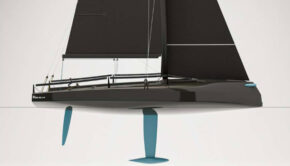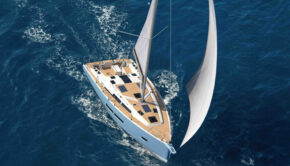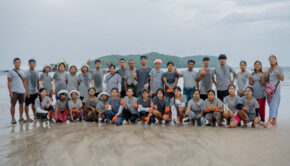The Boat Building Magic of Maine
Published on April 13th, 2017
Cabot Lyman was part of the wave of young turk boatbuilders who came to Maine yards in the late 1970’s and 80’s to bring struggling local marine businesses into the 20th century. In 1978, he founded Lyman-Morse Boatbuilding, making it the family business that his son Drew now oversees.
After a lifetime working his way around the marine construction firm, over the past few years Drew has taken over direct day-to-day control. Drew is now President, while Cabot is officially the Owner. When asked how his son was running his shop, Cabot was his traditional blunt self: “Drew doing a better job than I ever did.”
In this interview by Stephens Waring Yacht Design, Drew shares his perspective on what makes for a successful modern boat yard, where the future lays for this industry and what can be done to solve the never-ending problem of finding the right workers.Talk to us about what the modern integrated boat company actually is.
We run between 120 and 150 employees, with roughly 40 to 60 in our New Construction department; 15 to 20 in Metal Fabrication, and another 5 to 15 in our Technologies division.
The key idea is flexibility. We are not just committed to making a cold-molded boat or a carbon boat. We have worked hard to branch out into other disciplines. Our technologies division does work for the Department of Defense, and metal fab shop now does architectural work. We did a canopy and stainless work for Baruch College, in New York City. Diversification is the key.
Isn’t there a danger of being too diversified?
No, I embrace it. I get excited when a customer walks through our yard and sees an aerospace part being laid up, while a cold-molded boat is being made, while we are casting a new part for an architectural job. It’s just exciting to prove that we can build custom things for anybody. The client can feel that. I think that’s really important.
We are focusing a lot of attention on the technology side. We made a big investment with SolidWorks software. It’s expensive, but this investment allows us to connect that software back to our CNC machines, enabling us to make higher-quality parts.
That’s the story we want to tell: We invest in the robust tools to do the job right.
Do you see as many opportunities outside traditional boatbuilding as you do inside?
We see ourselves getting into custom-designed objects wherever we can. We have done displays for Coach bags. We worked with Vineyard Vines. We can be competitive when a project is complex or doesn’t require a huge production run.
What opportunities do you see in straight-up boatbuilding in next 3 to 5 years?
I’m seeing a growth in the market for semi-custom builds. While some people relish the custom experience, many people are fearful of taking on a custom project. It is not a question of money or time. People want to buy the largely existing boat. It is proven and it is running. We see ourselves tapping into that. We want to strike the right balance that brings that custom feeling to the production boat.
I am looking at a semi-production boat in the $1.5- to $2.5-million range. That’s the future.
Talk about your workforce. Domestic jobs are a political issue right now.
One of the struggles we have here in the U.S. is investing in proper schooling for the technological trades. I’d love to see more apprenticeship and internship programs that give people direct experience in tearing down engines, doing composite work and working with metals, etc.
The advantage of being in Maine, I feel, is that our labor force is the best. You’ve walked through this yard. There‘s a passion and pride for building boats in Maine that will never go away. Our clients feel that. You can’t teach that.









 We’ll keep your information safe.
We’ll keep your information safe.